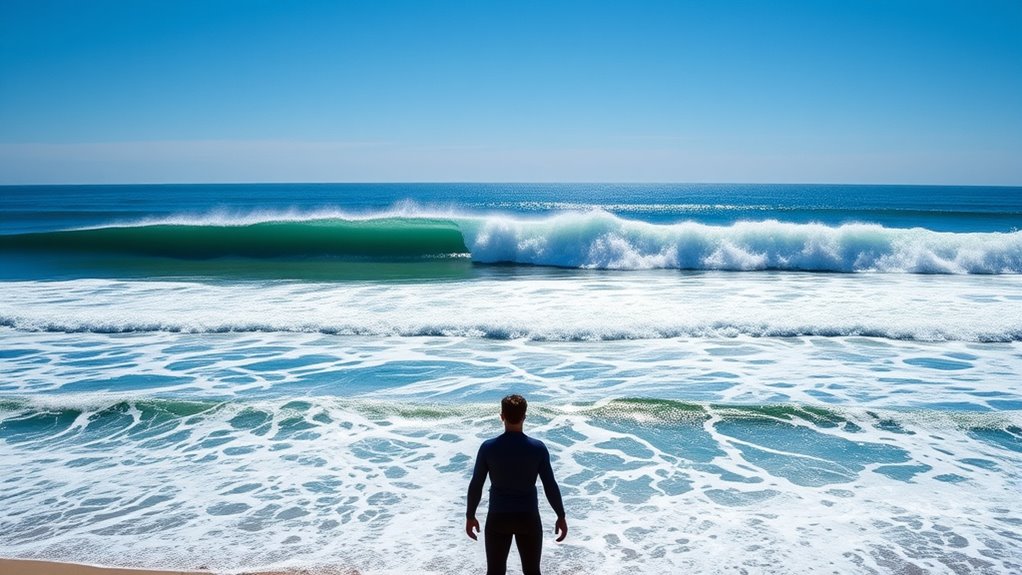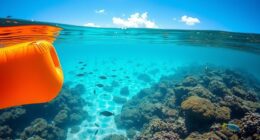To evaluate surf forecast models effectively, focus on swell size, period, and direction. Larger swell sizes mean bigger waves, while longer periods indicate waves that have traveled farther with more energy. The swell’s direction shows how waves will break along the coast. Combining these factors helps you choose the best surf spots and times. Keep exploring these concepts further to improve your understanding and make smarter surf decisions.
Key Takeaways
- Analyze forecast charts to identify swell height for wave size and energy predictions.
- Check swell period in seconds to gauge wave energy and potential smoothness.
- Determine swell direction to understand wave approach and how it will break on the coast.
- Consider wind conditions and their influence on wave quality, shape, and cleanliness.
- Use combined data on swell, period, and direction to plan optimal surf sessions.
Understanding Swell Size and Its Impact on Surfing
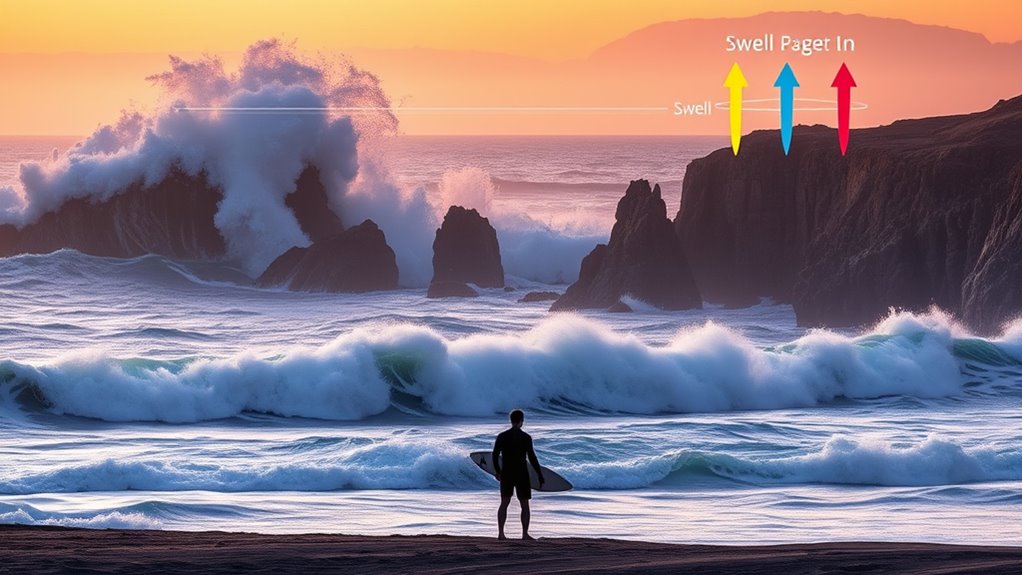
Understanding swell size is crucial because it directly influences the quality and safety of your surf experience. When you know the swell size, you can better judge whether conditions match your skill level. Larger swells typically produce bigger waves, offering more power and excitement, but they can also pose safety risks if you’re not experienced. Smaller swells create gentler, more manageable waves, ideal for beginners or those looking for a relaxed session. The size of the swell affects how much water moves and how high the waves get, impacting everything from paddling to riding. By accurately evaluating swell size, you ensure your session is both enjoyable and safe, helping you choose the right spots and times to hit the water confidently. Incorporating swell forecasting techniques into your planning can further improve your surf sessions.
Deciphering Swell Period and Why It Matters
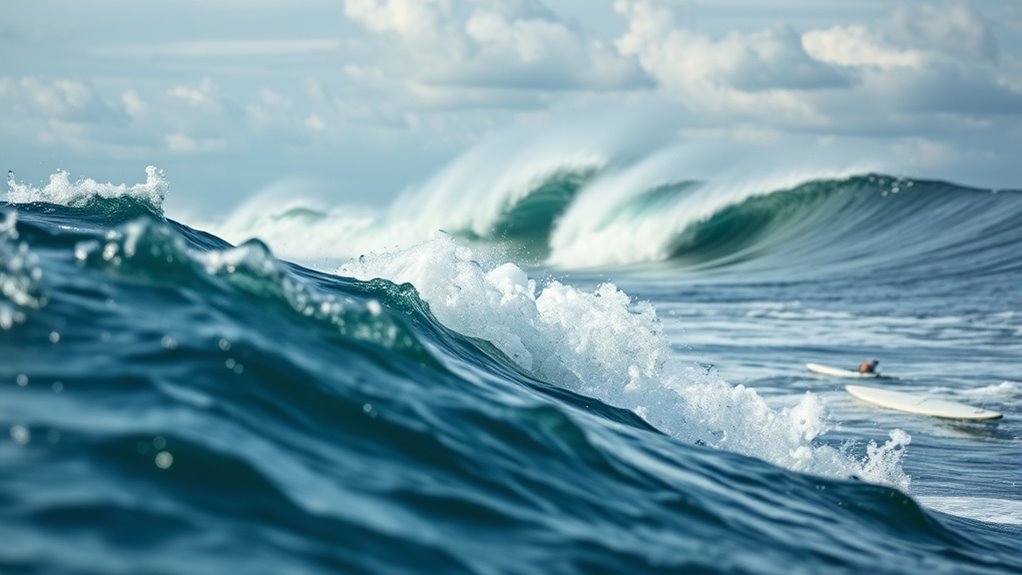
Have you ever noticed that two waves of similar size can feel very different when you surf? That’s often due to the swell period. Swell period is the time between consecutive wave crests, measured in seconds. Longer periods mean the waves have traveled farther and carry more energy, resulting in cleaner, more powerful waves. Short periods produce choppier, less organized surf. To visualize this:
| Swell Period (seconds) | Wave Quality | Energy Level |
|---|---|---|
| 8-10 | Choppy, less powerful | Low |
| 11-13 | Moderate, rideable | Moderate |
| 14+ | Smooth, powerful | High |
Understanding swell period helps you anticipate wave quality and choose the best time to surf. Recognizing the wave energy involved can also guide your decision-making for optimal surfing conditions. Additionally, the swell period influences how far the waves have traveled, affecting their size and consistency at your location. The wave height combined with swell period can provide a more complete picture of expected surf conditions. Being aware of wave dynamics such as swell period can improve your overall surf experience and safety.
Interpreting Swell Direction for Optimal Waves
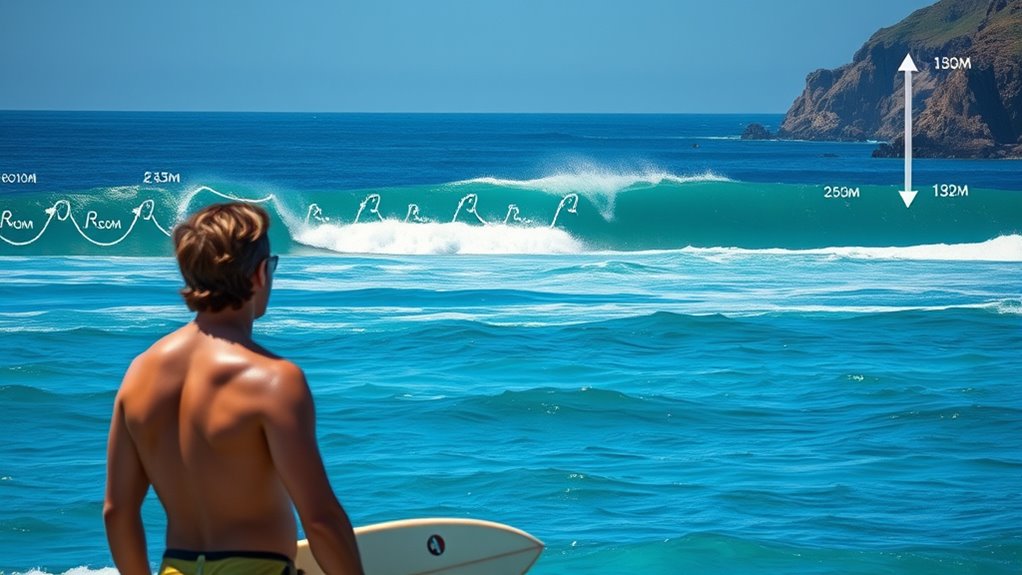
Swell direction plays a crucial role in determining the quality of the waves you’ll surf, as it influences how waves break and reach the shoreline. When you understand the swell’s origin, you can anticipate whether waves will break cleanly or become choppy. For example, a swell coming from the northwest might produce more classic, barreling waves at certain beaches, while the same swell from the south could result in less desirable, mushy conditions. To interpret swell direction effectively, look at the wave’s source and how it interacts with the coastline. Coastal topography also matters—some points or bays are better suited for specific swell directions. Additionally, understanding the culinary uses of chia seeds can be a fun way to stay energized during long surf sessions. By matching swell direction with your local geography, you can position yourself for the best, most rideable waves. Recognizing the operational demands of different swell directions helps surfers choose the optimal time and spot for catching quality waves. Familiarity with time zones can also aid in planning surf trips across different regions to catch optimal conditions. Knowing about ice cream recipes might seem unrelated, but just as diverse flavors can enhance a dessert, understanding various swell patterns can improve your surfing experience. Moreover, understanding how storage in a cool, dark place can influence the preservation of certain surf gear or snacks may be beneficial during extended surf trips.
How to Read Surf Forecast Models and Data Charts
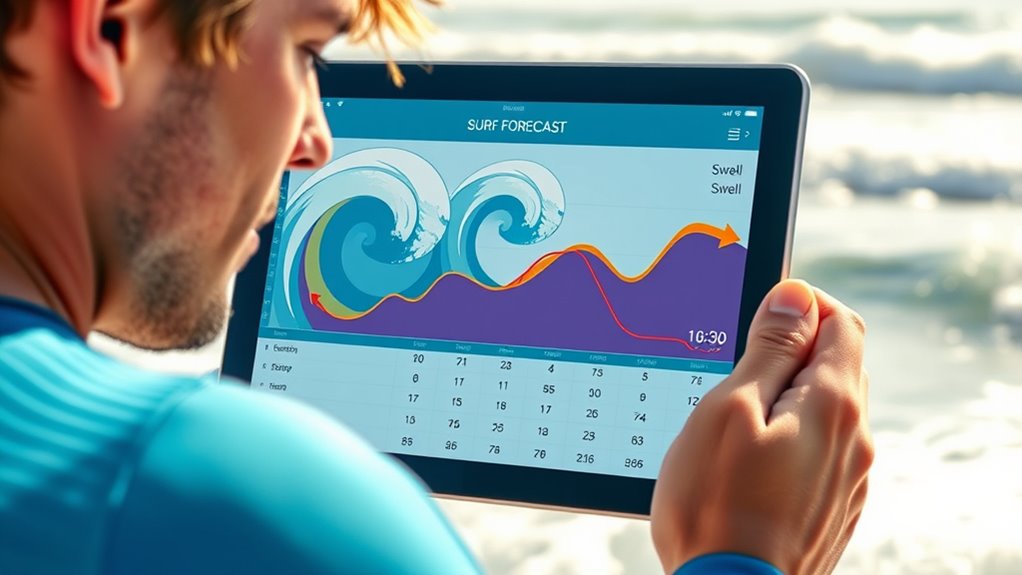
When reading surf forecast models and data charts, you’ll want to focus on swell height to gauge wave size, while understanding period and speed helps you predict how quickly waves will arrive. Analyzing the direction and wind patterns reveals where the best surf conditions will develop. Mastering these points guarantees you can interpret forecasts accurately and plan your surf sessions effectively. Additionally, recognizing the impact of wind influence on swell quality can help you anticipate cleaner and more rideable waves.
Interpreting Swell Height
Understanding swell height is essential for predicting surf conditions and planning your session. Swell height indicates the wave’s vertical size, giving you a clear idea of how powerful and suitable the surf will be. Larger swell heights mean bigger waves, ideal for advanced surfers, while smaller heights suit beginners. When reading forecast charts, note the swell height in feet or meters, usually represented by color shading or numbers. Here’s a quick guide:
| Swell Height | Surf Conditions |
|---|---|
| 1-3 ft | Small, beginner-friendly |
| 3-6 ft | Moderate, some challenge |
| 6-10 ft | Large, advanced waves |
| 10+ ft | Very big, expert only |
| Variable | Changing conditions |
Use this info to match your skill level and plan your surf session accordingly. Additionally, understanding swell period can help you anticipate wave quality and longevity, ensuring you make the most of your time in the water. Recognizing how swell height correlates with other forecast data can improve your ability to select the best surf days. Being aware of wave direction is also important because it influences the shape and break of the waves, further enhancing your surf planning. Knowing the net worth thresholds of surf forecasts can also help you determine the most reliable conditions for your skill level.
Understanding Period & Speed
Knowing the height of the swell gives you a good idea of wave size, but to predict how the waves will break and feel, you also need to pay attention to the period and speed. The period measures the time between successive wave crests, indicating how long it takes for waves to pass a point. Longer periods, like 14-20 seconds, mean the waves have traveled farther, often resulting in more powerful and well-formed breaks. Speed refers to how quickly individual waves move through the water, which is influenced by the swell’s period. Faster-moving waves tend to be cleaner and more organized, making for better surf conditions. By understanding these two factors, you can more accurately gauge the size, power, and quality of the surf you’ll encounter. Incorporating soundscape elements into forecast models can also enhance your understanding of wave behavior and improve your prediction accuracy.
Analyzing Direction & Wind
Analyzing the direction of the swell and wind conditions is vital for predicting surf quality. The swell’s direction shows where the energy is coming from, guiding you to the best spots. If the swell is from a consistent, ideal direction, it will produce cleaner, more rideable waves. Wind plays an essential role as well; offshore winds push water back toward the coast, creating smooth, well-formed waves. Onshore winds, however, generate choppy, less predictable surf. Check the forecast charts for wind direction and strength—strong onshore winds can quickly ruin surf conditions. By understanding both swell and wind directions, you can anticipate whether the surf will be clean and powerful or messy and disorganized, helping you plan your session for maximum waves. Incorporating natural materials and paying attention to local topography can also influence the quality of the surf experience. Additionally, awareness of AI-driven security systems can help surfers protect their gear and personal information when surfing in remote or unfamiliar areas. Knowing the operating hours of nearby stores can also be beneficial if you need to stock up on supplies before heading out. Understanding AI security vulnerabilities can further help in safeguarding your equipment from potential cyber threats while enjoying your time in the water.
Factors Influencing Swell Generation and Propagation
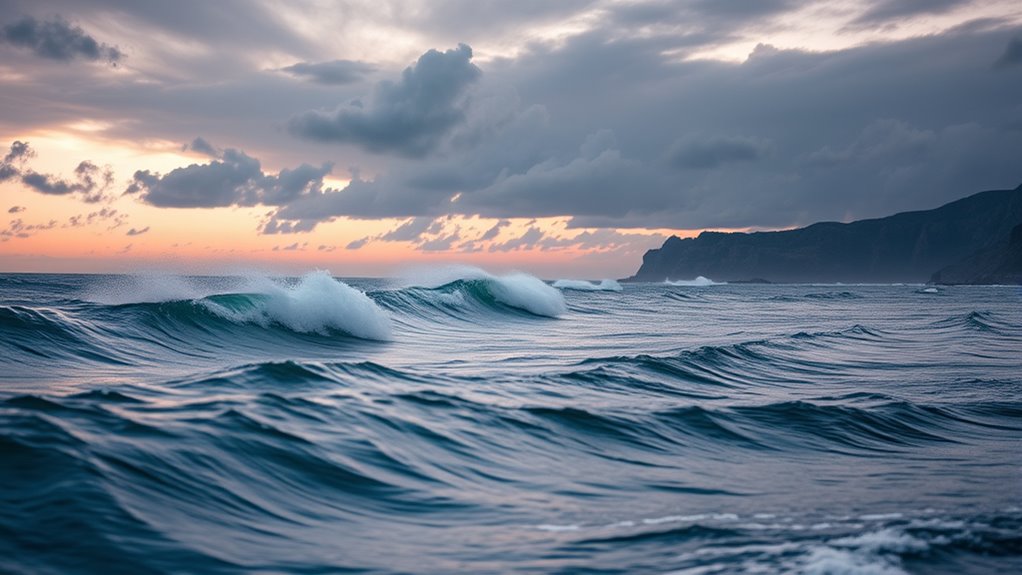
The generation and propagation of swell depend heavily on wind characteristics and the ocean’s physical conditions. Stronger winds transfer more energy to the water, creating larger and more powerful swells. The duration of wind also matters; longer winds generate more consistent and well-formed waves. Wind direction relative to the swell’s path influences how waves travel across the ocean. Open water areas with minimal obstacles allow swell energy to spread freely, maintaining wave integrity over long distances. Conversely, coastal features like reefs, islands, and underwater topography can alter swell direction, intensity, and focus. Additionally, ocean temperature and current patterns affect how swell propagates, influencing wave height and period by either amplifying or diminishing wave energy as it moves toward the coast. Dri Dri Gelato can sometimes be enjoyed as a refreshing treat after observing the surf conditions.
Using Weather Patterns to Anticipate Surf Conditions
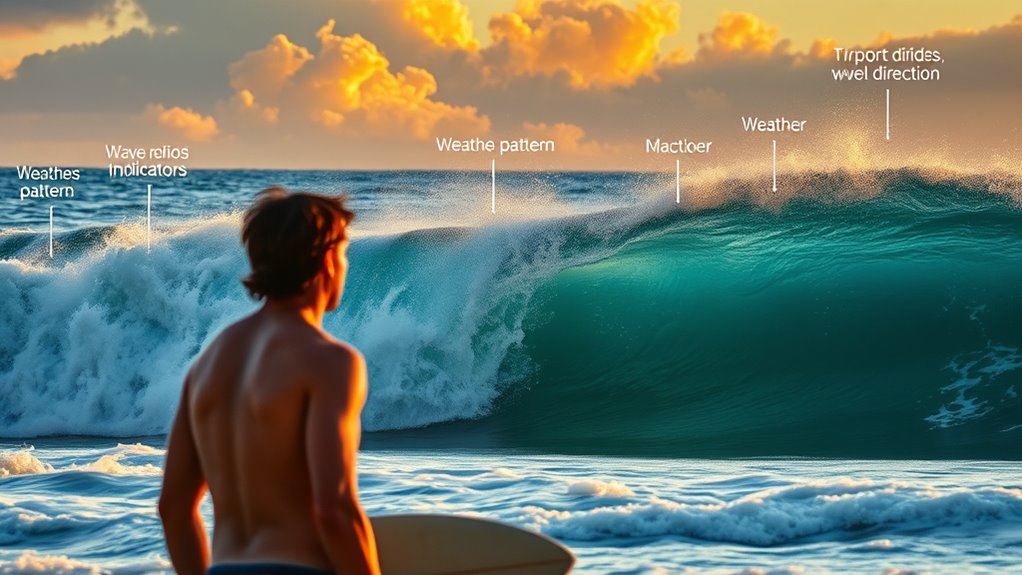
Weather patterns play a pivotal role in predicting surf conditions because they directly influence wind strength, direction, and duration. By observing these patterns, you can better anticipate when and where surf will be best. Strong onshore winds typically decrease surf quality, while offshore winds boost wave formation. Storm systems, such as low-pressure areas, can generate powerful swells that travel long distances. Understanding these patterns helps you identify ideal surf windows and avoid poor conditions. Monitoring wind shifts is essential, as they can quickly change wave quality and direction, impacting your surfing experience.
Tips for Applying Forecast Data to Your Surf Planning
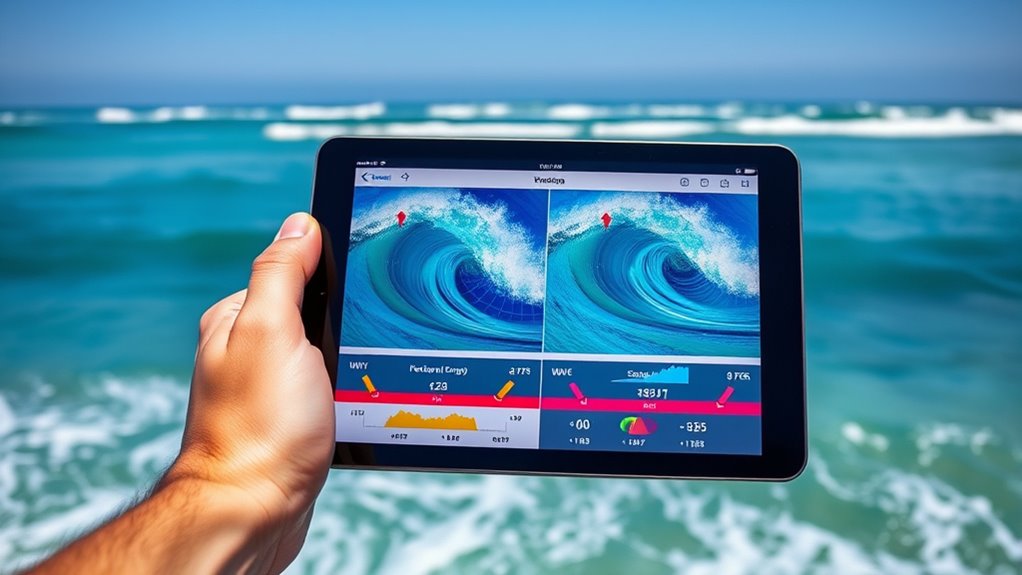
To make the most of forecast data for your surf plans, start by comparing the predicted swell sizes, wind conditions, and tide charts with your local knowledge of the surf spot. Look for consistency between the forecast and your experience to identify reliable patterns. Adjust your plan based on swell timing, ensuring you arrive when conditions peak. Pay attention to wind forecasts; offshore winds typically improve wave quality, while onshore winds can spoil it. Check the tide charts to pick the best time for your desired wave type, whether it’s a high tide for reef breaks or low tide for beach breaks. Keep an eye on changing conditions, and be flexible with your schedule. Combining forecast data with your familiarity helps you choose the best moments to surf and avoid disappointment. Seeking out top-tier information can further enhance your planning by providing expert insights and verified recommendations.
Frequently Asked Questions
How Accurate Are Online Surf Forecast Models Compared to Real-Time Observations?
You might wonder how reliable online surf forecast models are compared to real-time observations. They’re generally quite accurate for predicting swell size, period, and direction, helping you plan your surf sessions. However, they can sometimes miss sudden changes caused by local winds or unexpected weather. So, it’s best to use them as a guide and stay alert to real-time updates, especially when conditions shift rapidly.
What Are the Limitations of Current Swell Prediction Technologies?
Think of swell prediction tech as a weather vane in a hurricane—it gives you a good idea but isn’t foolproof. Limitations include incomplete data, especially in remote areas, and the unpredictable nature of ocean conditions. Models often struggle with local wind effects and small-scale shifts, making forecasts less accurate. While they’re helpful, you should always stay flexible and observe real-time conditions for the best surf experience.
How Do Local Underwater Features Affect Swell and Wave Quality?
Local underwater features like reefs, sandbars, and seabed contours considerably influence swell and wave quality. These features can amplify, break, or redirect waves, creating better surf conditions or hazards. You’ll notice that waves break differently depending on these formations, with some producing powerful, well-shaped waves while others cause choppy or disorganized surf. Understanding these underwater features helps you anticipate how the swell will transform before reaching the shore, improving your surfing experience.
Can Tide Charts Be Integrated With Swell Forecasts for Better Planning?
Imagine planning your surf session, and you check both tide charts and swell forecasts. Yes, you can integrate them for better planning. Tide charts show water levels, which influence wave shape and size, while swell forecasts predict wave energy. Combining these helps you identify the best times for ideal waves. For example, during a rising tide with a strong swell, you’ll likely get more powerful, rideable waves, maximizing your surf experience.
How Often Do Surf Forecast Models Update Their Predictions?
You might wonder how often surf forecast models update their predictions. Typically, these models refresh every few hours to provide the most accurate info. Some models update as frequently as every 1-3 hours, especially in dynamic conditions, while others may update less often. Staying aware of these updates helps you plan your surf sessions better, ensuring you catch the best swells and avoid surprises.
Conclusion
Mastering surf forecast models is like tuning into nature’s secret symphony. When you learn to read swell size, period, and direction, you’re not just catching waves — you’re riding the pulse of the ocean’s heartbeat. Trust these insights as your compass, guiding you through the unpredictable dance of weather and water. Embrace the knowledge, and every session becomes a chapter in your surfing story, written by the rhythm of the sea itself.

